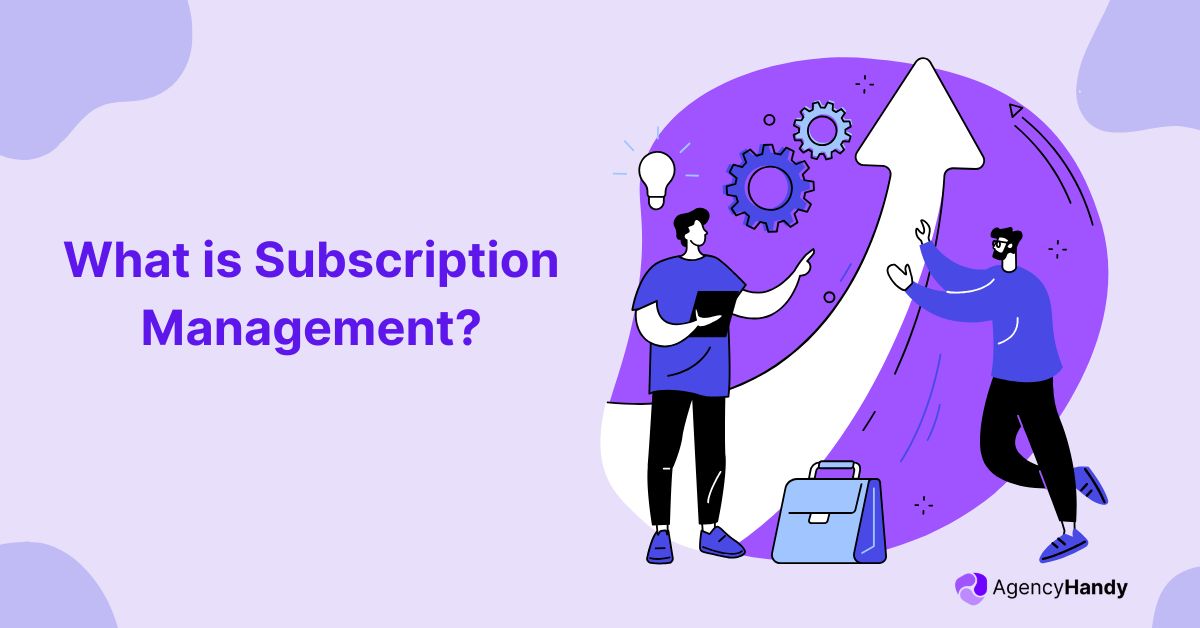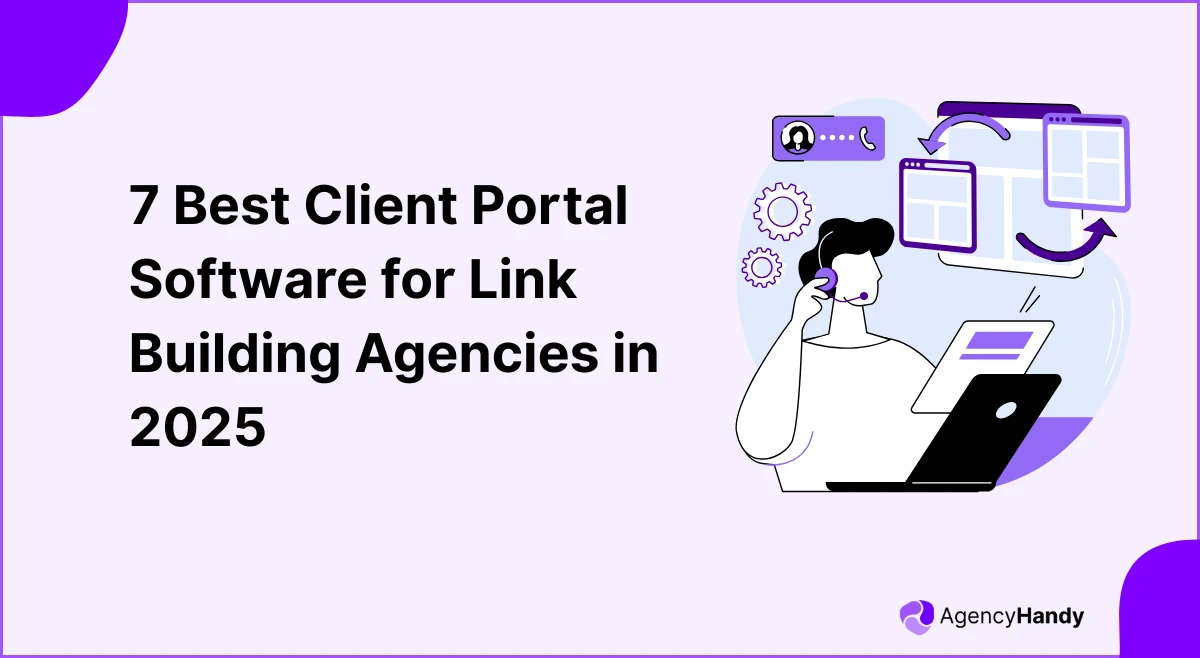Subscription-based businesses are booming, growing 4.6x faster than the S&P 500 in the past decade.
But with that growth comes complexity, renewals, billing, plan changes, and churn, all need tight control.
Subscription management is the process of managing every stage of a customer’s subscription from sign-up and billing to renewals and cancellations. It supports weekly, monthly, or annual models, ensuring accuracy and steady revenue.
In this guide, you’ll learn what subscription management is, how it works, why it’s important, and which tools can help you handle subscriptions with less stress.
What is Subscription Management?
Subscription management refers to the process of handling every aspect of your customer’s subscription. You handle sign-ups, billing, plan changes, renewals, and even cancellations. It helps you stay organized and gives your customers a smoother experience.
This model is growing fast. Research shows the global subscription billing market is expected to reach 17.95 billion dollars by 2030, growing at 16.9 percent every year starting in 2025.
If you’re managing a service-based business, tools like Agency Handy can save you time. It automates your recurring payments, tracks every active subscription, and even handles client invoicing, allowing you to focus more on your work and less on admin tasks.
Types of Subscription Management Models
Not every subscription works the same way. Depending on what you sell and who you sell to, you might need a different kind of subscription model. Here are the most common types of subscription management models you should know:
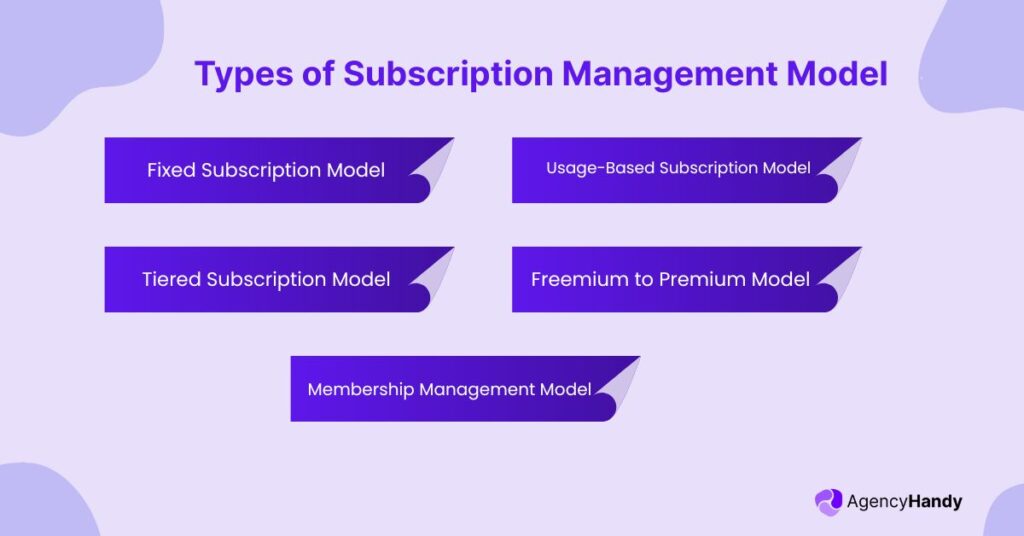
Fixed Subscription Model
In a fixed model, your customers pay the same amount at regular intervals, like monthly or yearly.
It is simple to set up and easy for customers to understand. Many streaming services and digital memberships use this model because of its simplicity.
Usage-Based Subscription Mode
In this model, customers pay based on how much they use your service. If they use more, they pay more. If they use less, they pay less. This is a popular choice for cloud services or utilities where customers needs can change month to month.
Tiered Subscription Model
A tiered model offers different levels of service at different price points. Customers can choose the plan that fits their needs and budget. This gives people flexibility and makes it easier for you to serve a wider range of customers.
Freemium to Premium Model
You start by offering a basic version of your service for free. Then you give customers the option to upgrade to a paid plan with more features.
This model works well if you want to attract a large number of users first and then convert them into paying customers later.
Membership Management Model
Membership models are common for clubs, education platforms, and communities. Customers pay for access to exclusive content, services, or experiences.
Managing memberships often requires keeping close track of renewal dates, member benefits, and engagement activities.
Why is Subscription Management Important?
Here are five key reasons why subscription management matters for any growing business:
Better Customer Experience
Subscription management tools help you avoid messy situations like billing errors, service interruptions, or confusing upgrade flows.
When customers can update their plan, billing details, or preferences easily, they feel in control, and that builds trust.
Higher Retention, Lower Churn
Losing a customer doesn’t just mean one missed payment. It means losing long-term revenue.
Good subscription systems let you identify at-risk users, automate renewal reminders, and offer timely discounts or upgrades, all before a user hits cancel.
Accurate Revenue Forecasting
With clean data flowing from billing, upgrades, and renewals, your finance team can see monthly recurring revenue (MRR), churn, and future growth. No more guesswork. You can plan with real numbers.
Fewer Manual Errors
Automating subscription processes reduces human errors. That means fewer missed invoices, fewer double charges, and less support workload. Your team saves time, and your customers avoid frustration.
Scalable Growth for Your Business
Whether you’re handling 50 customers or 5,000, manual tracking won’t keep up. A good subscription management system scales with you, helping you stay organized and efficient as you grow, without burning out your team.
How Subscription Management Works
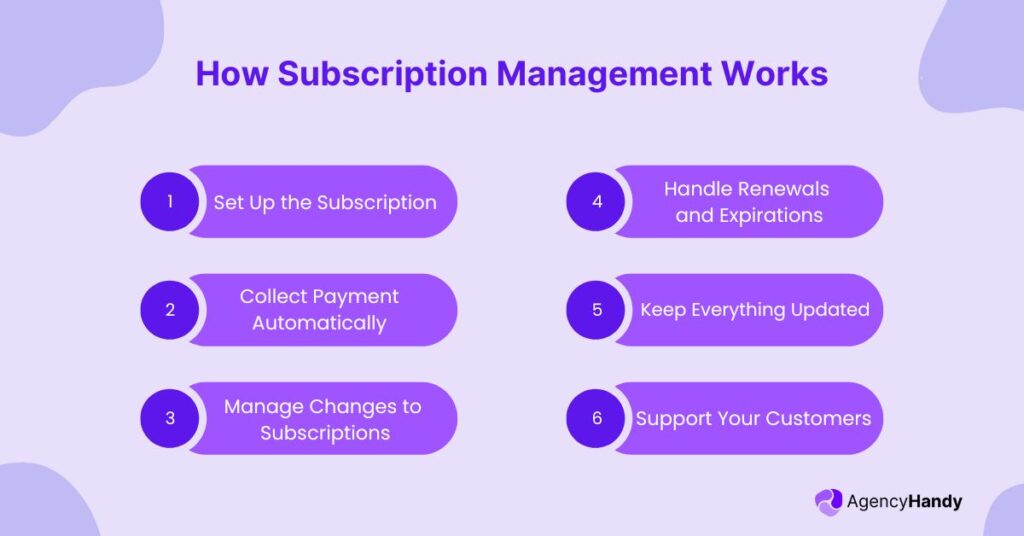
Managing subscriptions means taking care of everything after someone signs up. Here is how it usually works, step by step:
Step 1: Set Up the Subscription
After a customer signs up, you create their account and link their billing information. You also assign them to the right plan based on their choice. This setup ensures they can start using your service without any delay.
Step 2: Collect Payments Automatically
You need a billing system that charges your customers on a regular schedule, like monthly or yearly. Here, with subscription payment processing, taxes, discounts, and confirmations are handled automatically.
This way, you save time and avoid mistakes with manual billing.
Step 3: Manage Changes to Subscriptions
Over time, customers might want to upgrade to a better plan, downgrade to a simpler one, pause their subscription, or cancel it altogether.
A good subscription management system makes these changes easy for customers and updates everything in real time. This flexibility helps keep customers satisfied and in control.
Step 4: Handle Renewals and Expirations
Before a subscription renews, your system should send reminders to customers so there are no surprises.
If a payment fails, it should automatically retry and inform the customer about what happened. Handling renewals and expirations properly helps you avoid losing customers unnecessarily.
Step 5: Keep Everything Updated
Customer records, billing details, subscription statuses, and payment histories need to stay current at all times. A strong subscription management tool updates this information automatically as actions happen.
This saves you from doing manual updates and prevents small errors from turning into bigger problems.
Step 6: Support Your Customers
Sometimes customers have questions about their plans, payments, or account details. You need an easy way for them to reach you and get quick answers. Good support builds trust, reduces cancellations, and turns first-time users into loyal customers.
Subscription Management vs. Subscription Pricing: Key Differences
Subscription management and subscription pricing sound similar, but they focus on very different parts of your business. It is important to understand both so you can handle your subscriptions more effectively.
Here is a simple breakdown of how they compare:
| Feature | Subscription Management | Subscription Pricing |
| Main Focus | Managing the customer’s entire subscription journey | Setting the right price for subscription plans |
| Key Tasks | Billing, renewals, upgrades, downgrades, cancellations | Choosing pricing models like flat-rate, tiered, or usage-based |
| Goal | Improve customer experience and retention | Attract customers and maximize revenue |
| Tools Involved | Billing systems, CRM integrations, customer dashboards | Pricing strategy tools, market research |
| Customer Interaction | Continuous (throughout the subscription lifecycle) | Mainly at sign-up or when pricing changes |
| Impact on Business | Reduces churn, increases satisfaction, smoothens operations | Drives sales, affects competitiveness, influences profitability |
How to Choose the Right Subscription Management App
Choosing the right subscription management app is an important step. You need a tool that fits your business now but also has the power to grow with you over time.
Here are some key things to look for:
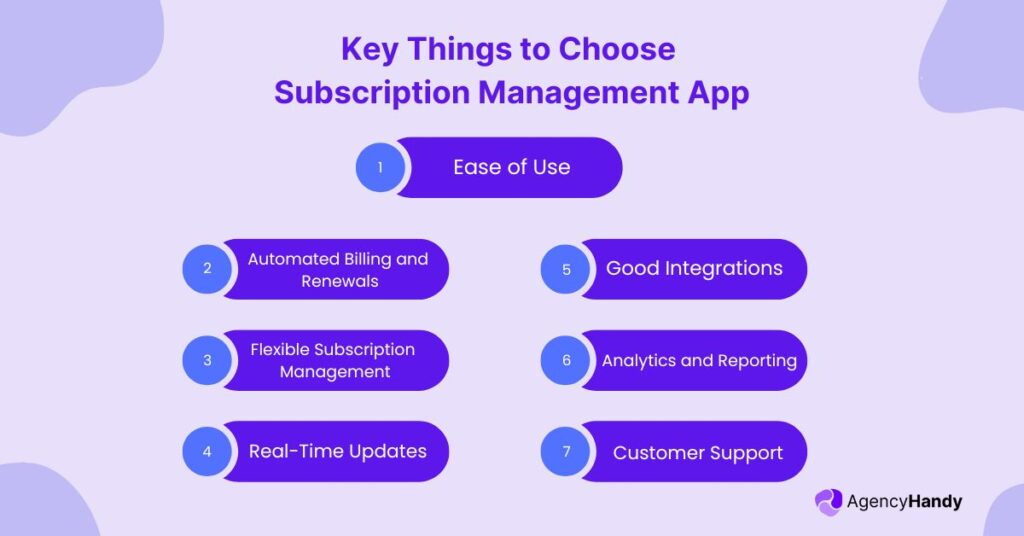
Ease of Use
The app should be simple to set up, even if you are not a tech expert. It should have a clean design and clear instructions that make everyday tasks easy.
If using the app feels confusing or frustrating, it will cause more problems than it solves.
Automated Billing and Renewals
Find an app that can automatically handle billing, renewals, and sending invoices. It should also be able to manage payment retries if a customer’s card fails.
Automation saves you from having to chase down payments manually each month.
Flexible Subscription Management
Customers should be able to upgrade, downgrade, pause, or cancel their plans at any time.
These changes should happen smoothly without needing your direct help. Flexibility makes customers happier and reduces your support workload.
Real-Time Updates
Select a system that updates customer details and payment statuses in real-time whenever changes occur.
This keeps your records accurate at all times without manual fixes. Real-time updates also help avoid billing mistakes that could upset your customers.
Good Integrations
Your app should work well with the other tools you already use, like payment gateways, CRM platforms, and accounting software. Integrations save time by syncing important data across systems.
They also make reporting and customer management much smoother.
Analytics and Reporting
A strong app will show you clear reports on key numbers like monthly recurring revenue, churn rate, and active subscribers.
These insights help you see where your business is doing well and where you might need to make changes. Without good reporting, it is easy to miss important problems.
Customer Support
Even the best software can occasionally experience issues. You need an app provider that offers fast and helpful support when you encounter a problem. Good support can save you hours of frustration and keep your subscription business running smoothly.
Conclusion
Understanding subscription management helps you take control of your business without feeling overwhelmed.
Start by keeping things simple. Make it easy for people to subscribe, upgrade, or cancel when necessary. Even minor tweaks in how you manage subscriptions can help build stronger trust and generate a more steady income.
If you want a simple way to manage it all, you can try Agency Handy. It provides an all-in-one client portal to manage subscriptions, billing, renewals, forms, orders, and team collaboration.
FAQ
What is subscription management in SaaS?
In SaaS, subscription management means handling customer sign-ups, billing, renewals, upgrades, downgrades, and cancellations. It makes sure everything runs smoothly after someone subscribes to your software service.
How does subscription lifecycle management work?
Subscription lifecycle management covers every stage of a customer’s journey, from starting a subscription to ending it. It manages sign-ups, billing, renewals, plan changes, and cancellations to keep the process simple and organized.
What are the best tools for subscription management?
Some of the best tools for subscription management include Chargebee, Recurly, Zuora, Maxio, and Agency Handy. They help automate billing, track customer activity, and make managing subscriptions much easier.
What’s the difference between billing and subscription management?
Billing is only about charging customers and collecting payments. Subscription management is bigger. It handles the full customer experience, including plan changes, renewals, cancellations, and billing in one system.
Why is managing subscriptions important for digital businesses?
Managing subscriptions well helps you keep customers happy, reduce churn, and make your revenue more predictable. It also saves time by automating billing and account updates, giving you more freedom to grow your business.

